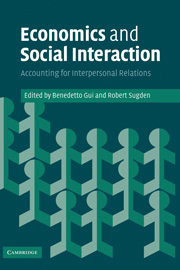Book contents
- Frontmatter
- Contents
- List of illustrations
- Notes on contributors
- Preface
- 1 Why interpersonal relations matter for economics
- 2 From transactions to encounters: the joint generation of relational goods and conventional values
- 3 Fellow-feeling
- 4 Interpersonal interaction and economic theory: the case of public goods
- 5 Under trusting eyes: the responsive nature of trust
- 6 Interpersonal relations and job satisfaction: some empirical results in social and community care services
- 7 On the possible conflict between economic growth and social development
- 8 The logic of good social relations
- 9 The mutual validation of ends
- 10 Hic sunt leones: interpersonal relations as unexplored territory in the tradition of economics
- 11 Authority and power in economic and sociological approaches to interpersonal relations: from interactions to embeddedness
- 12 Interpersonal relations and economics: comments from a feminist perspective
- 13 Economics and interpersonal relations: ruling the social back in
- Envoi
- References
- Index
- References
References
Published online by Cambridge University Press: 15 December 2009
- Frontmatter
- Contents
- List of illustrations
- Notes on contributors
- Preface
- 1 Why interpersonal relations matter for economics
- 2 From transactions to encounters: the joint generation of relational goods and conventional values
- 3 Fellow-feeling
- 4 Interpersonal interaction and economic theory: the case of public goods
- 5 Under trusting eyes: the responsive nature of trust
- 6 Interpersonal relations and job satisfaction: some empirical results in social and community care services
- 7 On the possible conflict between economic growth and social development
- 8 The logic of good social relations
- 9 The mutual validation of ends
- 10 Hic sunt leones: interpersonal relations as unexplored territory in the tradition of economics
- 11 Authority and power in economic and sociological approaches to interpersonal relations: from interactions to embeddedness
- 12 Interpersonal relations and economics: comments from a feminist perspective
- 13 Economics and interpersonal relations: ruling the social back in
- Envoi
- References
- Index
- References
- Type
- Chapter
- Information
- Economics and Social InteractionAccounting for Interpersonal Relations, pp. 271 - 294Publisher: Cambridge University PressPrint publication year: 2005

